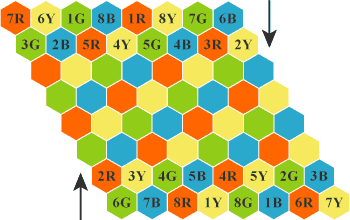-
| Four-color playing cards. Group 1st.
Four-color playing cards.
Four-color game board.
|
Description of the game set.
Four-color (quadricolour) hexagonal playing cards are a version
of the present board game in which one card deck consists of two
proportional groups. Namely 36 playing cards of one deck are distributed
on two game groups in which there are proportional ratio of colors (card
suits) and values. Images of four-color hexagonal playing cards and four-color 64-cell hexagonal game board are in the PDF file. Hexagonal playing cards in the shown board games can be open on cells of boards as in a chess or checkers, namely information can be open for players, but also there can be variants of gaming in which information is closed, that is similar to poker or different gambling in casino. Therefore it is possible to take the shown board games as "developing toys" which train logic thinking necessary for understanding of game strategy according to which it is possible to win in casino and to do correct hands in poker. That can be interesting to players and gamers who play poker or other hazardous gambling on web-sites or game portals of computer online casino in the world wide web of Internet. |
-
Four-color hexagonal playing cards can be applied to various gaming and
conundrums which can have different variants of rules. Namely it is possible to
spread cards in cells of the board during game, or it is possible to have
preliminary cards in cells and then to shift during game, or it is possible to
have preliminary cards in initial game positions and then to move on cells.
If game rules assume moving playing cards on cells then it is possible to
randomize cards in initial game positions, or it is possible to apply initial
positions in which playing cards are ordered that is shown in figure.
 |
As it is possible to see, two proportional groups in
the deck of four-color playing cards are located in initial game
positions on the different parties of the board that corresponds to
positions of two players on the different parties of the board. Each
player plays by 18 cards of own proportional group and focus arrows on
the opponent that allows to distinguish playing cards. And also players
distinguish own and another's cards by means of daggers which are on
playing cards in one of proportional groups. Suits and values of playing cards are shown in figure by numbers which designate values, and also shown by letters which designate suits (colors). In initial positions each playing card is located in a cell of corresponding color, namely each card is trump, but it is possible to apply positions in which playing cards are not trump. That is variants of initial game positions can be different that depends on features and rules of those or other games. |
-
If to turn 64-cell hexagonal board of game on 60 degrees then it is possible to apply game positions which are shown in following figure.
 |
In this case in each proportional group there are 16
playing cards, namely 9R and 9G (nine of red and nine of green) in one
proportional group and also 9B and 9Y (nine of blue and nine of yellow)
in the second proportional group are excluded from structure of the deck
of four-color playing cards. In essence 64-cell hexagonal board of game is similar to a chessboard in such position as there are 8 verticals and 8 horizontals, but cells of the boar are hexagonal and also cells have four colors that corresponds to four colors (suits) of playing cards. It is possible to try to play a chess on such 64-cell hexagonal board of game, but rules for moving of chessmen in hexagonal cells should be others rather than rules of moving in a traditional chess. |